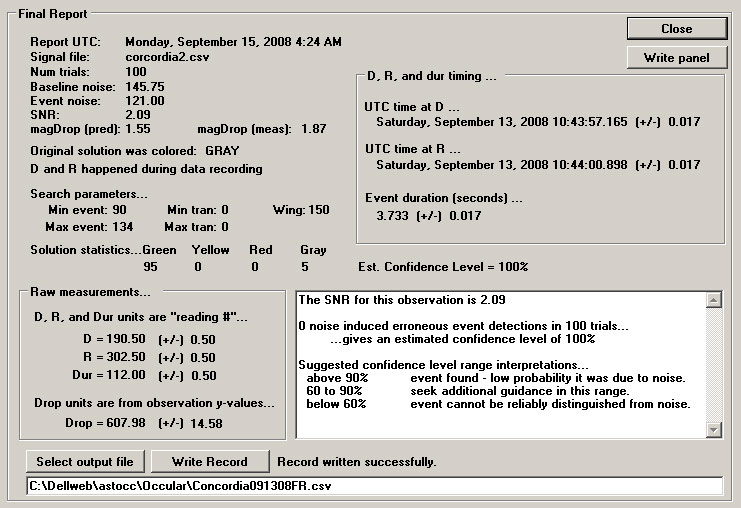

Sept 11-14, 2008
IOTA always builds these meetings around special occultation events. In this case, the best asteroid occultation in the U.S. this year crossed Apple Valley the evening of Sept 11, and the following night was another high-rank asteroid occultation also crossing over over Apple Valley. This is the site of our 2004 meeting - the Lewis Center for Educational Research. I thoroughly enjoyed my 3 day get-away for the good of science (and recovering my sanity). I also leanred how to use LiMovie and Occular to extract the maximum objective data from my video recordings, and some very cool plots as well.
The Metis Occultation. First event was the Thursday evening occultation of a 6.0 star by the 9.9 magnitude asteroid Metis - the best asteroid event of the year for the United States. Very high rank and there were promises of over 30 observers, making it potentially one of the best observed asteroid occultations ever. My plan was to observe from Mt. Pinos. However, I got a late start on Thursday, and weather satellite data showed warm thunderstorms coming rapidly in over the desert and heading west. I decided instead to observe from my old favorite - Caliente Ridge in Carrizo Plain National Monument. It was a good choice. It got me there in plenty of time, I was near the northern limit which had a flat predicted profile and the promise of perhaps a very rare asteroid grazing occultation. Weather turned out to be just fine, although murkey muck did cause a lot of extinction at low altitudes and the event was only 15 degrees up in the east. The LX200 did a great job go-to'ing on the right star the first time. All went well, and I got an 8 second occultation, out of a predicted central chord duration of 41 seconds, showing I was very close to the northern limit.
Set up my sleeping area with a great view of moonlit Soda lake miles in the distance below me, read some Brian Green "The Fabric of the Cosmos", and then got some sleep. Up at 7am, took some photos of Carrizo Plain - one of the most starkly beautiful places I know.
Then I drove over the back road through Pine Valley, Frazier Park, Gorman and on to Palmdale and the Panera Bakery cafe with its free WiFi. I adjusted my portfolios (poorly as it turned out) while sipping a fruit smoothie breakfast, and then continued on to Victorville and Apple Valley to join the IOTA Conference just as the business meeting was close to wrapping up. The science portion of the meeting is shown on this link.
The Metis Occultation. First up was collecting results for the Metis occultation the night before. David Dunham and especially Scott Degenhardt had very ambitious plans of laying out a total of 11 or 12 unmanned automated stations. The logistics of such an undertaking are pretty formidable, with a vast array of possibilities to go wrong and eat up precious time. For one, Scotty set up along Hwy 33 and (as it turns out) the U.S. Strategic Oil Reserve. Laying out camoflaged black gun-like things all aimed in unison across miles....brought down the security people in short order. In the end, Scotty got 7 stations layed out, and Dunham got 3 layed out. Scotty was near the northern limit and I worried that my site might duplicate his, but it turns out that he didn't get his southern-most 4 stations layed out, and my chord was well positioned in this gap. The final sky plane plot of all observations of this occultation is here.
|
LiMovie light curve |
Occular's model fit and light curve |
The Concordia Occultation was at 3:44am Saturday morning. In the planning session, I laid claim to a track at -3km from the centerline. Dunham planned to set up 5 stations along Hwy 247 between Lucerne Valley and Barstow. Scotty planned to set up a fence of stations near the northern limit. I took the centerline, planning to set up on a dirt road as far from civilization as I could reasonably hope to get. After planning, we retired to the chinese restaurant down the street, and then split. Dunham immediately went to work on his station setups, yet with one problem or another, still by 3:44am only could get 3 stations going. The number of possible snafu's that can get the asteroid occultationist continues to grow. In the debriefing the next day, I felt a little guilty as I had no real problems. Poor Scotty suffered through his second south shift and major challenges to get all his stations deployed, once again the southern-most ones were the ones sacrificed and the ones that might have gotten events. 16 misses in two nights, a record unlikely to be matched for some time. A noble soldier, is Scott. Here is the final sky-plane plot of all observations.
|
Light curve for my Concordia digital recording, from Occular v3.14. |
Occular v3.14 was downloaded on Saturday, and during dinner Scott Degenhardt showed me how to use this terrific software. There's an art to selecting the parameters, which I will describe on a HowTo webpage for asteroid occultation reductions. The Occular Final Report is imaged below, and the .xls report form is here, and was sent to IOTA on Sept 14.

At dinner on Saturday Scott Degenhardt sat with me and helped me learn how to use LiMovie and Occular. A million thanks, Scott! Great software and quite thorough in squeezing every bit of accuracy out of our video recordings.